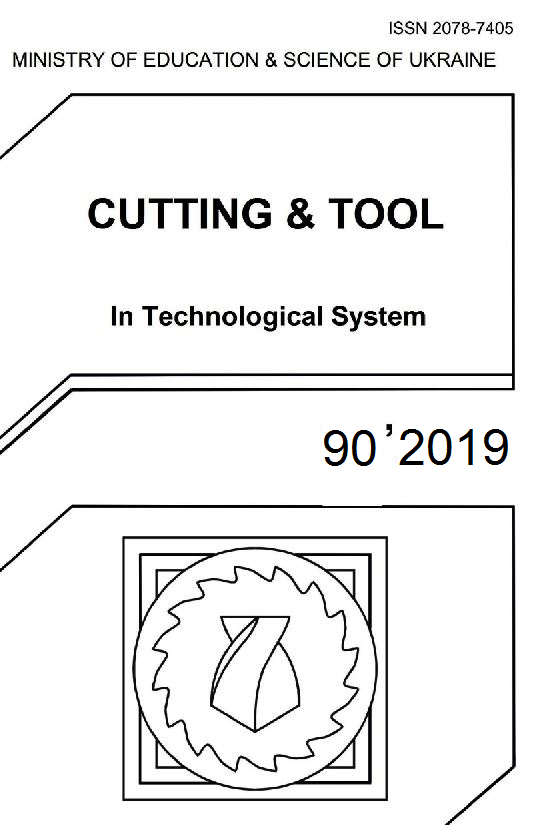EXAMINATION OF 3D SURFACE TOPOGRAPHY OF DIAMOND BURNISHED C45 WORKPIECES
DOI:
https://doi.org/10.20998/2078-7405.2019.90.16Keywords:
burnishing, Factorial Experimental Design, 3D surface roughness, experimental investigation, improvement ratio.Abstract
Nowadays cold working operations like rolling, burnishing are important finishing methods. In this paper the diamond burnishing of external cylindrical surfaces are studied. The principle of this process is that a pressing tool, which goes along the surface of the workpiece with linear motion having given parameters (e.g. feed) while the workpiece is rotating. Using of diamond burnishing has many preferences: surface roughness of the workpiece is improving, hardness of the surface is increasing while it’s micro-structure is also improving. Fatigue strength is increasing significantly due to the compressive residual stress in the subsurface area causing by burnishing. The aim of this study was to examine the influence of different burnishing parameters, such as burnishing speed, feed and force with the using of two different kinematic viscosity oil. For plan and execute the experiments we used the Taguchy type full factorial experimental design method by which empirical formulas can be created easily. The measurement of the surface roughness was executed with Altisurf 520 3D measuring equipment at the Institute of Manufacturing Science. The measured results were evaluated by the comparison of a special correlation formula to determine the optimal combination level of the different parameters in the given interval.References
L. Bálint, L.Gribovszki(1975). The basics of machine engineering technology, Miskolc, p:418-442. (in Hungarian).
M. Novák: Surfaces with High Precision of Roughness after Grinding. Manufacturing Technology, 12 (2012) 66-70.
J. Kundrák, Z. Gácsi, K. Gyáni, V. Bana, G. Tomolya: X-ray diffraction investigation of white layer development in hard-turned surfaces. Int. J. of Adv. Manuf. Techn., 62 (5-8), (2012) 457-469.
G. Gaszton, A. Kiss, J. Sárvári, M. Tisza: Moldy cold shaping, Tankönyvkiadó, Budapest (2008) p.: 315. (in Hungarian).
G. Varga: Possibility to increase the life time of surfaces on parts by the use of diamond burnishing process, Key Engineering Materials, Volume 686, 2016, pp.: 100-107.
G. Taguchi: System of experiment design, 1. Experimental design, UNIPUB, Kraus International Publications, White Plains, New York, (1987) ISBN 0-527-91621-8.
L. Fridrik: Chosen chapters from the topics of experimental design of production engineering, MűszakiKönyvkiadó, Budapest, 1987 (In Hungarian).
H. Luo, J. Liu, L. Wang, Q. Zhong, Investigation of the burnishing force during the burnishing process with a cylindrical surfaced tool. Int. J. Advertising of Manufacture Technology (2005) 25: 454-459.
Y. Xinbo, W. Lijiang, Effect of Various Parameters on the Surface Roughness of an Aluminum Alloy Burnished with a Spherical Surfaced Polycrystalline Diamond Tool. Int. J. of Machine Tools & Manufacture 39 (1999) 459-469.
A. Alexey Vereschaka: Improvement of working efficiency of cutting tools by modifying its surface properties by application of wear-resistant complexes. Adv. Mat. Research. Vols. 712-715. Trans Tech Publications, Switzerland, June. (2013) pp.: 347-351.
G. Varga: Can diamond burnishing be done in an environmentally friendly way? Applied Mechanics and Materials, Volume 474, 2014, pp.: 411-416.
L. Luca, S. Neagu-Ventzel, I. Marinescu: Effects of working parameters on surface finishing ball-burnishing of hardened steels. Precision Engineering (Elsevier) 29 (2005) pp.: 253-256 DOI:10.1016/j.precisioneng.2004.02.002.
T.A. El-Taweel, M.H. El-Axir: Analysis and optimization of the ball burnishing process through the Taguchi technique, Int. J. Advertising of Manufacture Technology (2009) 41: 301-310.
G. Varga.: Effects of Technological Parameters on the Surface Texture of Burnished Surfaces, Key Engineering Materials, Volume 581: Precision Machining VII, 2013, pp.: 403-408.
V. Molnár:3D measurement on the AltiSurf 520 type meter, Training Aid,University of Miskolc, Institute of Manufacturing Science (2012) p.:34 (in Hungarian).
ISO 25178 part 2 (2012) Geometrical product specification (GPS) - surface texture: areal - part 2: Terms, definitions and surface texture parameters. International Organization for Standardization.
G. Varga: Investigation of 3D surface roughness on environmentally friendly way milled surfaces. Rezanie I Instrumenty V Tekhnologicheskih Sistemah 81 (2012) pp.:24-33.
Downloads
Published
Issue
Section
License
Copyright Notice
Authors who publish with this Collection agree to the following terms:
1. Authors retain copyright and grant the Collection right of first publication with the work simultaneously licensed under a Creative Commons Attribution License that allows others to share the work with an acknowledgement of the work's authorship and initial publication in this Collection.
2. Authors are able to enter into separate, additional contractual arrangements for the non-exclusive distribution of the Collection's published version of the work (e.g., post it to an institutional repository or publish it in a book), with an acknowledgement of its initial publication in this Collection.
3. Authors are permitted and encouraged to post their work online (e.g., in institutional repositories or on their website) prior to and during the submission process, as it can lead to productive exchanges, as well as earlier and greater citation of published work.

